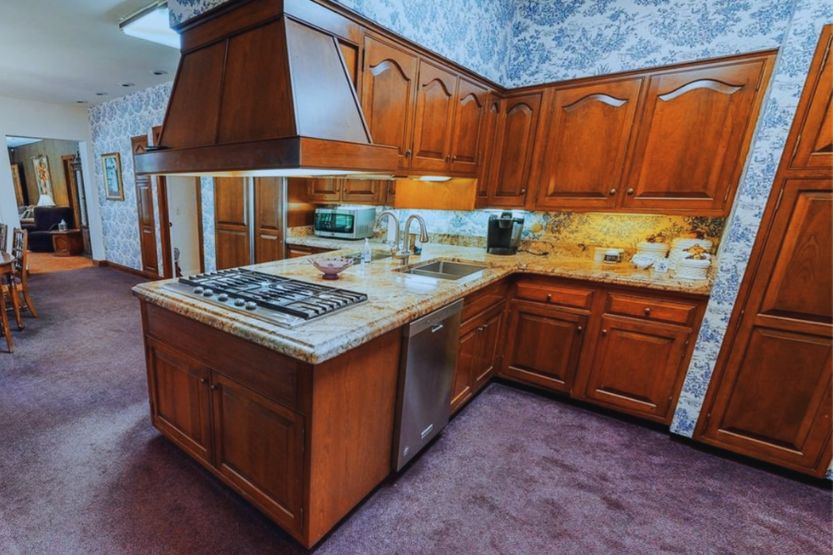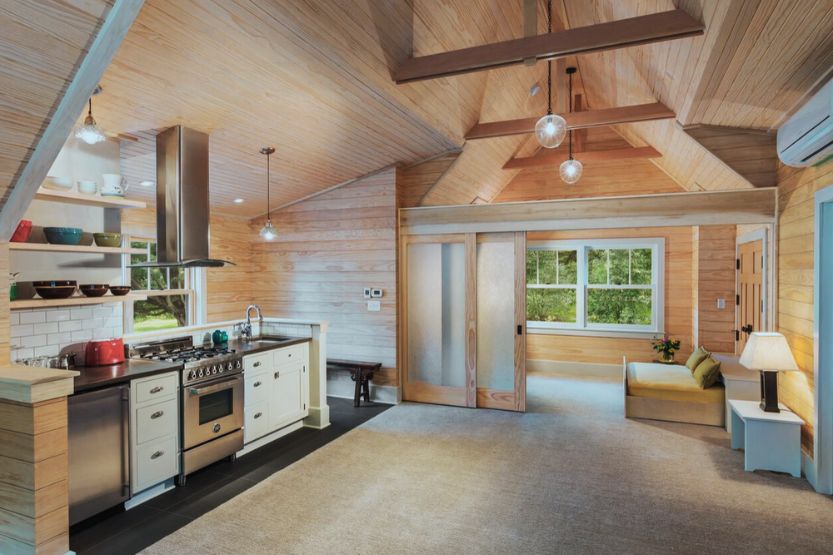I know what you might be thinking: What kind of a monster would want to have a carpeted kitchen floor? As scary as it sounds, some people like it. In this article, I’ll discuss why you should and shouldn’t have a carpeted kitchen and more!
So, which carpet is best for the kitchen? Use carpets that have short fibers and are made from materials that are easy to clean, such as polypropylene, PVC, and vinyl. Carpets or rugs made from cotton or wool stain easily, so avoiding them is best.
Read on to learn more about the upsides and downsides of a carpeted kitchen floor, the history of kitchen carpets, carpeted kitchen meme, and carpeted kitchen creepypasta.
Creepypasta and Carpeted Kitchen: What’s the Connection?

Creepypastas Are a Collection of Horror and Paranormal Stories
In case you’re not familiar, Creepypastas are a collection of horror and paranormal stories which netizens voluntarily share on the internet. But over the years, it has become a blanket term for any horror-related story on the internet. Creepypastas can be short or contain multiple chapters.
Combination of Creepy and Copypasta
Creepypasta was first coined on the anonymous imageboard website 4chan around 2006 or 2007. It’s a combination of two words: creepy and copypasta.
Copypasta Refers to a Small Piece of Text Repeatedly Copied and Pasted on the Internet
Copypasta refers to a small piece of text that has been repeatedly copied and pasted on the internet, specifically in internet forums and social media platforms.
What Does the Carpeted Kitchen Have to Do with Creepypasta?
Well, nothing. A Reddit user named u/mlgizdead posted a picture of a carpeted kitchen on the subreddit “r/creepypasta” a few years ago.
As you might’ve expected, the reaction of Redditors was that of horror. Below are just some of their comments:
Redditor u/Blofeld007 said the carpeted kitchen was scary because removing the stains would be difficult.
Redditor u/mOnIkA_RTJ_WREKONIZE claimed it was the “most terrifying post” in the entire subreddit.
Lastly, according to Redditor u/StringBeans2009, people from a small town in Missouri seemed to love carpeted kitchens because the first two apartments they lived in there had a carpeted kitchen.
Now that’s out of the way, let’s talk about carpeted kitchens.
History of Carpeted Kitchens
For us in the 21st century, it isn’t easy to imagine our kitchen floor covered in carpet. But in the past, carpeting was only reserved for the well-to-do. So, with that said, let’s discuss a bit of the history of the U.S. carpet industry and when carpeted kitchens became popular in the country.
2,000 or 3,000 B.C
Some of the oldest carpets were made as early as 2,000 or 3,000 B.C. They were made from goat’s hair or sheep’s wool. People during that period mainly used them to make sitting on the ground more comfortable.
16th Century
In the early 16th century, when the English established colonies in America, British ship captains brought oversized looms used to make rugs. These rugs were usually made from woven wool and were big.
19th Century
But only in the 19th century did the carpet industry in the United States begin. William Peter Sprague opened the first woven carpet mill in Philadelphia, Pennsylvania, in 1971.
As the years went by, the U.S. carpet industry grew, and mills became more advanced and efficient. This made it possible for carpet mills to offer their high-quality carpets to people in most income brackets faster.
Late 1960s
However, it wasn’t until the late 1960s that carpeted kitchens became popular. Before that period, only wealthy people could afford wall-to-wall carpeting. The newest technology gave manufacturers more freedom to experiment with different lengths.
1970s
They were able to make them available at different prices and quality levels. So, by the 1970s, carpets were in every room in a house—even bathrooms and kitchens.
Pros and Cons of a Carpeted Kitchen

Today, carpeted kitchens are only found in old homes. They don’t appeal much to modern homeowners because of their potential downsides. But are they that bad?
Before you make up your mind, you might want to consider the pros and cons of having a carpeted kitchen:
Pros
1. Makes Your Kitchen Warmer
Cold kitchens, especially in older homes, can be warmed up using carpets. Good-quality, thick carpets don’t create warmth. Their closely woven fibers can trap air, so if your heater runs, the warm air stays inside the room longer.
This allows you to lower your central heating thermostat, which can help you save on your annual heating cost.
Wools of New Zealand research shows carpets are ten times more insulating than hard floor coverings. For instance, thick carpets have better insulation than laminate, linoleum, wood, and vinyl.
2. Provides Shock Absorption
Older people, children, and people with disabilities are more susceptible to slips, falls, and other accidents. One way of ensuring the safety of your entire household is by installing carpets with thick and dense piles in high-traffic areas of your home, such as the kitchen.
Choosing the right carpet pad is also essential to ensure the comfort and safety of your whole family. People commonly make a mistake by buying too thick carpet padding.
The industry rule of thumb is to choose a carpet pad that’s not thicker than 7/16 inches and no thinner than 1/4 inches, weighing 6 to 8 pounds per cubic foot.
3. Cozy and Soft
We’ve always known this: Walking on a soft, freshly cleaned carpet feels better than walking on cold, hard floors. The smooth surface also helps relieve pressure from your feet, so you can work more comfortably and longer in the kitchen.
What makes a kitchen carpet soft? The fibers of a carpet can influence its softness. A strand of carpet fiber is called a filament. These filaments are bundled together to make a single fiber. The rule of thumb is the more refined the filaments, the softer a carpet is.
The material of a carpet is also an important consideration. Many consider wool as the softest carpet fiber. But since low-grade wool is prone to staining, some manufacturers would often combine it with synthetic fibers.
The cut pile tends to be softer underfoot than the loop pile. A cut pile is a style of carpet that starts as a loop pile, but the top of the loops are cut out to leave upright clusters of fiber. Another advantage of a cut pile is it usually resists crushing and matting because it’s highly twisted.
4. Better for Your Feet
Standing for extended periods on hard surfaces (e.g., cement floors, tiles, and wood) can affect the health and function of your ankles, feet, hips, knees, and spine. This is especially true in people with inflammatory joint conditions, such as osteoarthritis.
It also increases people’s risk for other foot problems, such as capsulitis (inflamed base of the second toe) and plantar fasciitis (inflamed ligament along the bottom of the foot).
In a Swedish Work Environment Authority (SWEA) study, researchers wanted to find out how various flooring materials absorb shock at a work facility.
Employees at that work facility suffered from pain in their feet, hips, knees, and lower spine due to the building’s floor and ground surfaces.
Unsurprisingly, the researchers found that installing a carpet in the workplace can improve comfort and help stop injuries more than hard floor coverings.
5. Hides Ugly Floors
If you can’t stand your ugly kitchen floor, one of the fastest ways of changing it is to cover it with a carpet. But not just any carpet! Your kitchen carpet should have the correct color and pattern to hide dirt while keeping the area looking clean and stylish.
Let’s talk about colors. Dark-colored carpets are much better at hiding stains. The darker the shade, the better it can conceal most stains.
Tip: The chosen color should always match or complement your kitchen’s dominant tone.
Instead of a plain or solid-colored carpet, choose one with a bold pattern. The beautiful and intricate designs and colors will help draw the eyes away from dirt or stains.
6. Quick to Install
You don’t want the wall-to-wall carpeting because it’s not a one-person or one-tool job. Use peel-and-stick carpet tiles because they’re easier and faster to install.
They already have an adhesive backing, so all you need to do is stick them to your clean kitchen floor. Another advantage of using carpet tiles is the only tool you need is a box cutter.
7. Funny Kitchen Carpet Memes
Kitchen carpets can also be fun. They’re available in various styles, colors, and sizes to fit your unique preference. You can even place a rug with a meme design over your solid-colored kitchen carpet to add humor and vary the texture.
Again, is it good to have a carpet in the kitchen? A carpeted kitchen has many benefits, including a warm kitchen and a more comfortable working area. Plus, the carpet can relieve some pressure off your feet.
Cons

1. Needs Regular Maintenance
In most households, kitchens are the heart of the home. And because of that, carpets will get dirty often, which means regular cleaning and maintenance.
The general guideline is to clean carpets at least two times a week. The Carpet and Rug Institute suggested hiring professionals to deep-clean carpets every 12 to 18 months.
2. Eventually Wears Out
Even the most durable and highest quality carpet will eventually show wear and tear, mainly if your kitchen receives a lot of foot traffic. The average carpets lifespan is between 5 to 15 years from installation.
3. Challenging to Clean
Aside from being out of style, another main reason people stay away from kitchen carpets is they’re more challenging to clean than tiles or concrete floors. Some stubborn carpet stains are coffee, cooking oil, chocolate, colored drinks (e.g., red wine), tomato sauce, and pet urine.
You can do the cleaning all by yourself. But if you have a busy lifestyle or are dealing with tough stains, it’s better to let professionals do it.
On average, carpet cleaning services cost between $120 and $230. Steam carpet cleaning, also known as deep carpet cleaning, costs around $100 to $400.
How to Get Gum Out of Carpet – 6 Easy Ways
4. Traps Dirt and Toxins
Carpets are magnets for the following:
- Dirt
- Dust
- Dust mites
- Mold spores
- Pet dander
- Other allergens
Suppose you don’t regularly clean your kitchen carpet. In that case, you and your loved ones could suffer from several health problems affecting your respiratory system (e.g., asthma, cough, and breathing problems) and skin (e.g., eczema, itchy skin, and rashes).
They could also contribute to indoor air pollution. Some of the chemicals used in installing carpets and carpet pads emit volatile organic compounds (e.g., benzene, formaldehyde, and styrene) that can negatively affect your health.
5. Absorbs Bad Odor
Compared to other surfaces in your home, such as your walls, carpet fibers will soak up unpleasant odors from just about anything (e.g., grease, cigarette smoke, and spills).
Trapped moisture is also a significant contributor to foul smells and could cause mold and mildew growth, which increases your risk for allergic reactions.
Fortunately, there are a few preventive measures that you could try to make things better. For instance, you could vacuum your kitchen carpet regularly, twice a week, or every other day.
Do it more often if you always use your kitchen or have pets freely roaming that part of your home.
Other ways to deodorize your carpet:
- Dilute white vinegar in water, then spray it on your kitchen carpet regularly or as needed.
- Clean spills, pet urine, and other messes immediately.
- In the case of stubborn odors (e.g., pet urine or feces) and stains, enzymatic cleaners can help eliminate them.
Conclusion – Carpeted Kitchen Pros, Cons, Meme, Creepypasta
Nowadays, many people consider kitchen carpets an abomination. They’re also high maintenance and have potential health risks.
But they do have their advantages. They’re worth considering if you have feet, knee, or back problems. If you’re not into wall-to-wall carpeting, try a small carpet or rug and place it somewhere in your kitchen where you spend most of your time standing.
Read next:









